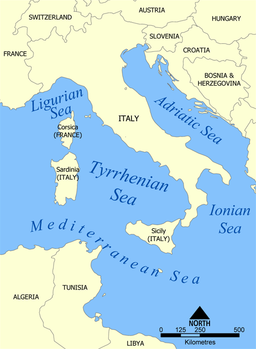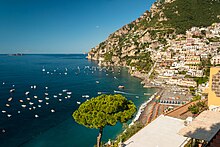Tyrrhenian Sea
| Tyrrhenian Sea | |
|---|---|
 Tyrrhenian Sea | |
| Location | Mediterranean Sea |
| Coordinates | 40°N12°E/ 40°N 12°E |
| Type | Sea |
| Etymology | From the ancient people ofTyrrhenians |
| Basincountries | Italy,France |
| Surface area | 275,000 km2(106,200 sq mi) |
| Average depth | 2,000 m (6,562 ft) |
| Max. depth | 3,785 m (12,418 ft) |
TheTyrrhenian Sea(/tɪˈriːniən,-ˈreɪ-/,tih-REE-nee-ən,-RAY-;[1]Italian:Mar Tirreno[martirˈrɛːno]or[-ˈreː-])[note 1]is part of theMediterranean Seaoff the western coast ofItaly.It is named for theTyrrhenian peopleidentified with theEtruscansof Italy.
Geography
[edit]The sea is bounded by the islands ofCorsicaandSardinia(to the west), theItalian Peninsula(regions ofTuscany,Lazio,Campania,Basilicata,andCalabria) to the north and east, and the island ofSicily(to the south).[2]The Tyrrhenian Sea also includes a number of smaller islands likeCapri,Elba,Ischia,andUstica.[3]


The maximum depth of the sea is 3,785 metres (12,418 ft).
The Tyrrhenian Sea is situated near where theAfricanandEurasian Platesmeet; therefore mountain chains and active volcanoes, such as MountMarsili,are found in its depths. The eightAeolian IslandsandUsticaare located in the southern part of the sea, north ofSicily.
Extent
[edit]TheInternational Hydrographic Organizationdefines the limits of the Tyrrhenian Sea as follows:[4]
- In theStrait of Messina:A line joining the North extreme of Cape Paci (15°42′E) with the East extreme of the Island ofSicily,Cape Peloro (38°16′N).
- On the Southwest: A line running from Cape Lilibeo (West extreme of Sicily) to the South extreme of Cape Teulada (8°38′E) inSardinia.
- In theStrait of Bonifacio:A line joining the West extreme of Cape Testa (41°14′N) in Sardinia with the Southwest extreme of Cape Feno (41°23′N) in Corsica.
- On the North: A line joiningCape Corse(Cape Grosso, 9°23′E) in Corsica, withTinettoIsland (44°01′N9°51′E/ 44.017°N 9.850°E) and thence throughTinoandPalmariaislands to San Pietro Point (44°03′N9°50′E/ 44.050°N 9.833°E) on the coast of Italy.
Exits
[edit]There are four exits from the Tyrrhenian Sea (north to south):
| Exit | Location | Width | Connected Sea |
|---|---|---|---|
| Corsica Channel | betweenTuscanyandCorsica42°50′N9°45′E/ 42.833°N 9.750°E | about 80 kilometres (50 mi) | Ligurian Sea |
| Strait of Bonifacio | betweenCorsicaandSardinia | 11 kilometres (6.8 mi) | Mediterranean Sea(proper) |
| no name | betweenSardiniaandSicily | about 290 kilometres (180 mi) | Mediterranean Sea(proper) |
| Strait of Messina | betweenSicilyandCalabriaon the toe ofItaly | 3 kilometres (1.9 mi) | Ionian Sea |
Basins
[edit]TheTyrrhenian Basinis divided into two basins (or plains), the Vavilov plain and the Marsili plain. They are separated by theundersea ridgeknown as the Issel Bridge, afterArturo Issel.[5]
Geology
[edit]The Tyrrhenian Sea is aback-arc basinthat formed due to therollbackof the Calabrianslabtowards South-East during theNeogene.[5]Episodes of fast and slowtrenchretreat formed first the Vavilov basin and, then, the Marsili basin.[6]Submarine volcanoesand the active volcanoMount Stromboliformed because trench retreat produces extension in the overriding plate allowing themantleto rise below the surface and partially melt. Themagmatismhere is also affected by the fluids released from the slab.
Name
[edit]Its name derives from the Greek name for theEtruscans,first mentioned byHesiodin the 8th century BC who described them as residing in central Italy alongside the Latins.[7][8][9][10][11]The Etruscans lived along the coast of modernTuscany,LatiumandCampania,and referred to the water as the "Sea of the Etruscans".
Islands
[edit]
Islands of the Tyrrhenian Sea include:
- Corsica
- Sardinia
- Sicily
- Tuscan Archipelago
- Ischia
- Procida
- Capri
- Ustica
- Aeolian Islands[12](includingLipariandStromboli)
- Pontine IslandsincludingPonza
Ports
[edit]The main ports of the Tyrrhenian Sea inItalyare:Naples,Palermo,Civitavecchia(Rome),Salerno,Trapani,andGioia Tauro.There is alsoBastia,located inCorsica.
Note that even though the phrase "port of Rome" is frequently used, there is in fact no port in Rome. Instead, the "port of Rome" refers to the maritime facilities at Civitavecchia, some 68 km (42 miles) to the northwest of Rome.[13]
Giglio Portois a small island port in this area. It rose to prominence, when theCosta Concordiaran aground near the coast of Giglio and sank. The ship was later refloated and towed toGenoafor scrapping.[14]
Winds
[edit]InGreek mythology,it is believed that the cliffs above the Tyrrhenian Sea housed the four winds kept byAeolus.The winds are theMistralfrom theRhônevalley, theLibecciofrom the southwest, and theSiroccoandOstrofrom the south.
Image gallery
[edit]Notes
[edit]- ^French:Mer Tyrrhénienne[mɛʁtiʁenjɛn]Latin:Tyrrhēnum mare,Sardinian:Mare Tirrenu,Corsican:Mari Tirrenu,Sicilian:Mari Tirrenu,Neapolitan:Mare Tirreno
References
[edit]- ^Longman, J.C. (2008).Longman Pronunciation Dictionary(3 ed.). Pearson Education ESL.ISBN978-1405881173.
- ^The Editors of Encyclopaedia Britannica."Tyrrhenian Sea".InChisholm, Hugh(ed.).Encyclopedia Britannica.Cambridge University Press.RetrievedJuly 18,2017.
- ^"Tyrrhenian Sea - Map & Details".World Atlas.RetrievedJuly 18,2017.
- ^Limits of Oceans and Seas(PDF).Vol. 172 (3rd ed.). 1953. p. 17.Bibcode:1953Natur.172R.484..doi:10.1038/172484b0.S2CID36029611.RetrievedMay 2,2020.
{{cite book}}:|work=ignored (help) - ^abSartori, Renzo (2003)."The Tyrrhenian back-arc basin and subduction of the Ionian lithosphere"(PDF).Episodes.26(3).University of Bologna:217–221.doi:10.18814/epiiugs/2003/v26i3/011.Archived fromthe original(PDF)on December 19, 2008.
- ^Faccenna, Claudio; Funiciello, Francesca; Giardini, Domenico; Lucente, Pio (2001). "Episodic back-arc extension during restricted mantle convection in the Central Mediterranean".Earth and Planetary Science Letters.187(1–2): 105–116.Bibcode:2001E&PSL.187..105F.doi:10.1016/s0012-821x(01)00280-1.ISSN0012-821X.
- ^Hesiod,Theogony1015.
- ^Barker, Graeme;Rasmussen, Tom(2000).The Etruscans.The Peoples of Europe. Oxford: Blackwell Publishing. p. 44.ISBN978-0-631-22038-1.
- ^Turfa, Jean MacIntosh(2017). "The Etruscans". In Farney, Gary D.; Bradley, Gary (eds.).The Peoples of Ancient Italy.Berlin: De Gruyter. pp. 637–672.doi:10.1515/9781614513001.ISBN978-1-61451-520-3.
- ^De Grummond, Nancy T.(2014). "Ethnicity and the Etruscans". In McInerney, Jeremy (ed.).A Companion to Ethnicity in the Ancient Mediterranean.Chichester, UK: John Wiley & Sons, Inc. pp. 405–422.doi:10.1002/9781118834312.ISBN9781444337341.
- ^Shipley, Lucy (2017). "Where is home?".The Etruscans: Lost Civilizations.London: Reaktion Books. pp. 28–46.ISBN9781780238623.
- ^"Map of Tyrrhenian Sea - Tyrrhenian Sea Map, History Facts, Tyrrhenian Sea Location - World Atlas".www.worldatlas.com.Retrieved20 March2018.
- ^"Civitavecchia (Port of Rome) | Rome for Visitors".europeforvisitors.com.Retrieved2024-03-28.
- ^"Costa Concordia comes home to die".The Telegraph.2014-07-27.Retrieved2024-03-27.














